Fundamental Summary of GMP Facility Contamination Control
Any manufacturer in the healthcare and medical industry must meet strict quality standards to keep end users safe and ensure treatment efficacy. The Food and Drug Administration (FDA) requires a wide range of well-designed and documented processes that demonstrate the quality of the final product.

To meet these regulations, pharmaceutical manufacturers implement strict guidelines and controls, such as Good Manufacturing Practices (GMP), to minimize the risk of contamination and cross-contamination.
If GMP standards are not met, the Food and Drug Administration may impose steep fines or legal penalties, require recalls, or otherwise impede your ability to operate. Some specific aspects of these practices focus on mitigating possible contamination and cross-contamination.
When done correctly, GMP facilities are clean, personnel are properly trained, and processes are designed to segregate different products and stages of production effectively.
Meeting GMP requirements is business-critical, so we’ll be breaking down everything pharmaceutical manufacturers need to know about contamination and cross-contamination control so they can continue providing high-quality products.
What is Contamination and Cross-Contamination in Pharmaceutical Manufacturing?
Looking at the general definition, contamination in manufacturing is the unintended presence of any type of substance or organism in a product. It can occur at any stage of the manufacturing process.
Contamination in pharmaceutical manufacturing, food, and cosmetics environments can compromise product safety and efficacy. That’s why GMP facilities have taken every precaution to produce high-quality pharmaceutical or medical products.
Cross-contamination is best defined as transferring contaminants from one product to another. This subset of contamination typically happens when multiple products are manufactured within the same facility or with shared equipment.
Three Primary Types of Cross-Contamination and Contamination
Contamination and cross-contamination can come in many specific forms that fall under three categories. Understanding the different types of contamination is essential for implementing effective preventive measures:
- Physical contamination: This category occurs when physical substances are unintentionally introduced into the product. Common physical contaminants include hair, dirt, dust, and pollen. These materials can come from various sources, such as the production environment, materials, or personnel, and can significantly impact the quality and safety of the product.
- Chemical contamination: Chemical contaminants include any unintended chemicals that enter the product. These might be residues of cleaning agents, lubricants used on machinery, or chemicals from other products manufactured in the same facility. This harmful type of contamination can alter the product's chemical composition and possibly lead to harmful reactions or substandard efficacy.
- Microbiological contamination: This type of contamination refers to microorganisms such as bacteria, molds, spores, and yeasts in the product. Biological contamination is a significant concern because it can lead to spoilage, product degradation, and even infections in end users.
The above 3 types of contamination are overarching categories, and we can further drill down into specific causes of cross-contamination, such as:
- Batch-to-batch contamination occurs when a product batch is contaminated by residues from a previous batch of the same product due to inadequate cleaning or separation during manufacturing processes.
- Product-to-product contamination is similar. It occurs when different products contaminate each other due to non-compliant storage or production processes.
- Foreign material contamination happens when products not part of the manufacturing process mistakenly enter the product. This is a common source of contamination in areas like the dispensary or storage where raw materials are handled and stored.
- Cross-contamination can also occur between different production areas, personnel or through inadequately designed airflow systems that fail to prevent the spread of particulates or microbes.
You can see how strict processes to prevent contamination are necessary to guard against any situation in which unwanted substances negatively affect the end product.
Preventing Cross-Contamination in Your GMP Facility
How can you take steps to keep unwanted substances out of your pharmaceutical products? GMP standards shed light on specific processes to adopt, such as which storage practice could cause cross-contamination.
Ultimately, cross-contamination is prevented by implementing and refining a series of processes that take a holistic approach to keeping contaminants out of your products. So, let’s explore which six control measures will prevent cross-contamination.
- Dedicated facilities and equipment: Maintain dedicated spaces and equipment to prevent cross-contamination between production lines. Conduct frequent inspections to ensure these areas meet cleanliness and operational standards.
- Proper sanitization and cleaning processes: Implement stringent sanitization and cleaning protocols to remove contaminants effectively. Regularly review and update these processes to adapt to new standards, production needs, or identified concerns.
- Documentation and record keeping: Keep thorough records of all processes, deviations, and implemented corrective actions. This documentation is crucial for traceability, GMP compliance, and continuous improvement. Refine documentation creation and storage, which is a strategy for reducing the risk of cross-contamination.
- Employee training and hygiene: Conduct comprehensive training programs focused on GMP, proper hygiene practices, the context of pharma manufacturing, and contamination prevention. Have regular refreshers to help maintain high standards and adapt to any necessary changes.
- Material handling and storage practices: Manage raw materials with specific protocols for handling and storage to minimize contaminant exposure related to the material’s stated requirements. Proper organization and material segregation are key practices for maintaining product integrity.
Using air control systems: Install advanced air control systems, such as HEPA filters, to manage particulates and microbial contamination in production areas. Develop processes for regular maintenance of these systems to ensure their effectiveness and reliability.
Measures to Control Contamination in Good Manufacturing Practicesph
We’ve explored how to prevent cross-contamination, but how can you prevent contamination overall?
The above prevention measures can certainly apply to other ways foreign substances can become exposed to your products, but it’s worth discussing specific contamination controls to consider other sources of contaminants.
Contamination Control in Cleanrooms
Cleanrooms remaining clean is crucial for maintaining product integrity, but contamination is a constant concern. The main sources of contamination include the surrounding environment outside of the room, operators, and raw materials.
Most cleanrooms are designed with specific airflow patterns and room pressures to protect products. Positive air barriers, dust extractors, and containment hoods keep foreign substances outside to minimize contamination.
Contamination Controls over Incoming Raw Materials
Controls that evaluate incoming goods are essential to the integrity and quality of the materials used in the manufacturing process.
Every lot of material received must be assigned a unique identification number to facilitate traceability. Inspecting these goods for any signs of transit damage or contamination upon arrival is crucial. Once accepted into the facility, the materials should be stored properly to minimize the risk of contamination.
Before being used in manufacturing, materials must undergo additional checks for identity, cleanliness, and the integrity of the storage container or protective wrapping to confirm their suitability.
Contamination Controls for Machinery and Equipment
Contamination control by machinery is necessary, as machinery can often be a source of contamination that is not immediately visible, such as oil or lubricant leaks and metal particles from wear.
To mitigate these risks, personnel must adhere to strict cleaning protocols and follow company procedures meticulously. Operators must ensure that machines are thoroughly cleaned and inspected for cleanliness before and after use.
Additionally, monitoring during operation is necessary to detect any signs of malfunction that could introduce contaminants into the product, such as leaks or unusual wear.
Regular preventive maintenance, rather than just breakdown maintenance, is also critical to minimize the risk of contamination. Schedules should be based on machine age, usage, and specific service needs.
Contamination Controls for Operators and Personnel
Operators are a significant source of possible contamination. A comprehensive approach helps control contamination risks operators pose in production environments, such as:
- Strict personal hygiene is vital for all staff, regardless of their direct involvement with the product.
- To prevent contamination from skin particles, body oils, and hair, direct contact with exposed products or their containers should be avoided.
- Operators should also avoid wearing jewelry during production as it can introduce dirt and debris or inadvertently fall into the product.
- Protective garments should be required when handling materials and be replaced with clean ones if wet or dirty.
Personnel adherence to these practices is essential to mitigate the risk of contamination. It’s critical that operators understand and follow these procedures and others unique to your manufacturing process to avoid contamination that can harm patient treatment and risk non-compliance.
Is Your Pharmaceutical Facility cGMP Compliant?
Earning a GMP compliance certification and maintaining compliance is crucial for pharmaceutical manufacturers to prevent non-compliance penalties and protect end users from possible harm.
Contamination and cross-contamination put patients and compliance at risk. Providing employees with ongoing cGMP training is critical to reinforcing practices and processes designed to prevent contamination.
CfPIE is a leader in
life sciences training, and we offer programs for facilities and professionals to learn the in-depth knowledge necessary to fully comply with GMP standards. Our courses are designed to impart the understanding of both processes and the practical skills necessary to execute them.
Do your teams need initial or ongoing education to help prevent contamination?
Learn more about our GMP certification program today to see how we prepare your teams to keep patients safe.
Blog Categories
Stay Informed


